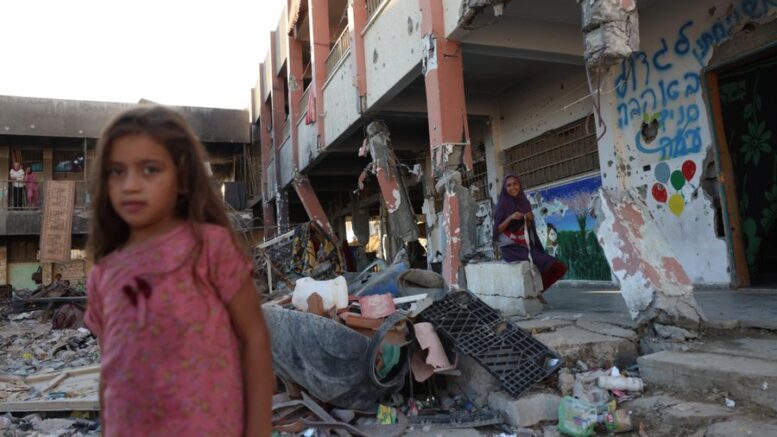Here’s how teachers can push back
Commentary by Bill Bigelow
Scholasticide.
It’s a term coined in 2009, but has taken on new power as the devastation of Gazan schools, universities, and libraries becomes almost total. As Rice University Professor Abdel Razzaq Takriti of Scholars Against the War on Palestine said about the Israeli assault: “They’re demolishing universities and schools intentionally. They bombarded and destroyed every single university. They’re using schools as barracks and military stations.”
But another facet of scholasticide can be found in our own schools in the United States—erasing Palestinian lives and hiding the history of Palestine-Israel from young people.
In the forthcoming book from Rethinking Schools, Teaching Palestine: Lessons, Stories, Voices, Palestinian American educator Nina Shoman-Dajani writes: “Of the hundreds of assignments my children have brought home from school over the years, not one of them has referred to Palestine.”
In a review of children’s literature on Palestine, in the book, Nadine Foty, Palestinian-Egyptian-American early childhood educator, writes: “As a child, I remember feeling like I didn’t belong because I could never walk over to a map in my classrooms and see my father’s home, Palestine. When I asked, I was met by responses that Palestine didn’t exist.”
The curricular silence that turns Palestinians invisible impoverishes all young people. Instead of the knowledge they need to make sense of how Palestine became Israel and how Israel continues to wage war on Palestinians, they get nothing. Or worse.
Widely adopted corporate textbooks feed students pernicious myth after myth. Glencoe’s World History, for example, begins its section “The Question of Palestine” not with Palestinians, but with Jewish immigrants: “In the years between the two world wars, many Jews had immigrated to Palestine, believing this area to be their promised land.” The entire section simply tells Israel’s origin story as Israeli propagandists would tell it.
About Israel’s founding, Holt McDougal’s Modern World History lectures young people: “The new nation of Israel got a hostile greeting from its neighbors.” The first “Critical Thinking” question in the teacher’s edition asks: “What prevented the establishment of the Arab state in 1948?”
The sole possible answer the book offers: “Palestinian Arabs rejected the partition plan.” (That partition plan was seen by many as a temporary inconvenience, including Israel’s first Prime Minister, David Ben-Gurion, who wrote partition was “not the end but the beginning.”)
The good news is that more and more teachers around the country are breaking through the mainstream curriculum’s silences and lies.
Teaching Palestine collects stories of imaginative teaching from across the country: a simulation that introduces students to Israel’s apartheid system of fragmentation and domination; a critical thinking activity with students evaluating Palestinian narratives on the 1948 Nakba (the Catastrophe), alongside Zionist narratives that fill our textbooks; an historical dive into U.S. policy choices toward Israel from the 1956 Suez Canal Crisis through Hamas’s rise to elected power in Gaza in 2006; a role play activity on the ”seeds of violence” in Palestine-Israel that transports students to Palestine in the Ottoman era and the early years of Zionist immigration and ethnic nation-building alongside Palestinian dispossession; an elementary lesson that uses Malak Matar’s poignant children’s book Sitti’s Bird: A Gaza Story.
But attempts to silence critical teaching around Palestine-Israel have at times been ferocious. And it requires courage for teachers to confront this repression.
Some instances feel absurd. In Portland, Oregon, in response to student work on Palestine posted on the walls of a public school last spring, the school district recently instituted a new administrative directive. Now, teachers may display art or posters that might “stimulate and illustrate” an area of study, but if these are visible from a “common area” like the hallway, they must have prior approval from the building administrator. This fall, school officials tore down—literally —a teacher’s “Stop the Genocide” posters. In a meeting, administrators said that “Stop Genocide” would be permissible, but inserting “the” rendered this unacceptably partisan.
Bill Bigelow is the curriculum editor of Rethinking Schools. He is editor of “Teaching Palestine”, along with Jesse Hagopian, Suzanna Kassouf, Adam Sanchez and Samia Shoman.
Source: inthesetimes.com, October 7, 2024.

